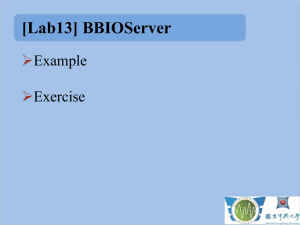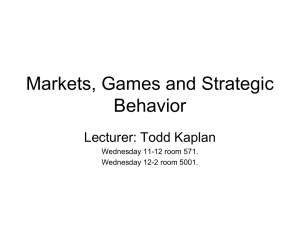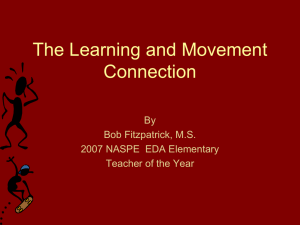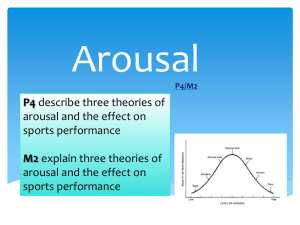Affect in web interface: A Study of the Impacts of Web page Visual
advertisement
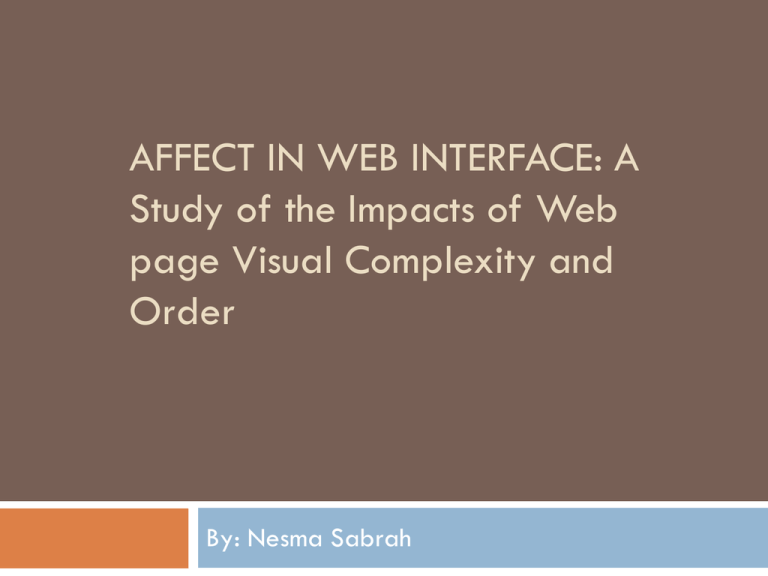
AFFECT IN WEB INTERFACE: A Study of the Impacts of Web page Visual Complexity and Order By: Nesma Sabrah Introduction Designing for usability has been one of the primary foci on HCI. The affective perspective of user interface design emphasizes the user’s subjective experience with the interface. by nature, human beings are judgmental i.e. assigning positive or negative valence to the environment. Affect linkages Attitudes AFFECT Cognitions Motivations Introduction (continued) Bucy argues that emotional responses determines which interface people choose to use. They seek pleasure and enjoyment beyond task efficiency. Webpage visual complexity and order are important design features that affect user’s initial emotional responses towards a website. This research investigates web user’s emotional reactions to different webpage designs with varying levels of visual complexity and order. Theoretical Background – The M-R Model The M-R model suggests that emotions function to mediate the effects of environmental stimuli on behavior. It assumes that people’s emotions determine what they do and how they do it and that people respond with different sets of emotions to different environments which induces to approach or avoid these environments. Approach-Avoidance behaviors predicts that user’s emotional responses affects whether: they stay within the particular site or leave the site and move onto other site. The Approach-avoidance Behavior Approach-avoidance behavior is considered important to this study because: a user’s behavior reflects the user’s perception of the quality of the website it strongly predicts desired behaviors pertaining to the measurement of the success of a website such as customer service, total number of hits, user’s return rate. it will lead to more time spent browsing, greater exploration of products and hence, probability of purchase. Complexity and Order Complexity Arnheim defines complexity as “the multiplicity of the relationships among parts of an entity.” Complexity is related to the visual richness, information rate, diversity and variety of information in an environment. Order Arnheim defines order “as the degree and kind of lawfulness governing the relations among the parts of an entity.” Order is the degree of organization of the environment in relation to coherence, congruity, legibility and clarity that it exhibits. Kaplan and Kaplan’s Preference Framework (1983) It is a perspective on aesthetic preferences that explains how visual complexity and order influence people’s preference of environment. There are two cognitive processes crucial to human survival: Making Sense: Coherence and legibility Involvement: having complexity and mystery Lavie and Tractinsky’s Study Similarly, user’s perceptions of website aesthetics consist of two dimensions: 1. 2. Classic Aesthetics – orderly, clear, clean and symmetrical design of a website. Expressive Aesthetics – visual richness, diversity and complexity. Both dimensions positively influence feelings of pleasure and usability. Emotions Arousal • The subjective experience of energy mobilization for psychological and motor activity. Valence • It is the subjective feeling of pleasantness or unpleasantness. Reversal Theory Reversal theory proposes two different meta-motivational states: Telic State 1. characterized as goal-oriented in which the ultimate goal is perceived as essential. A high level of arousal is experienced as unpleasant and associated with anxiety since it interferes with the achievement of the goal. Paratelic State 2. Is related to excitement seeking Characterized as acivity-oriented where the goal of the activity is not important compared to the ongoing activity. A high level of arousal is experienced as pleasant whereas low level is experienced as unpleasant. Research Model Relation between visual complexity and order AND emotional responses. Complexity (diverse and numerous information) has been consistently shown to be positively related to arousal(energy mobilization). Order (coherence, clarity and diversity) has been found to bear a negative relationship to arousal since it requires less energy to comprehend. Reversal Theory AND Emotional responses In a telic state, a webpage with high complexity and low order (high arousal)will create unpleasant feelings since it decreases task efficiency and requires high energy. And vice versa. In a paratelic state, a webpage with high complexity and low order would be gratifying and pleasant as it satisfies the need for a rich, stimulating experience. And vice versa. HYPOTHESES (1 AND 2) H1: The level of webpage order negatively influences the user’s feeling of arousal. H2: The level of webpage complexity positively influences the user’s feeling of arousal. HYPOTHESES (3 AND 4) H3: A web user’s meta-motivational state moderates the effect of webpage order in the user’s feeling of pleasantness. H3a: in a telic state, level of order positively influences pleasantness. H3b: in a paratelic state, order negatively influences pleasantness. H4: A web user’s meta-motivational state moderates the effect of webpage visual complexity on the user’s feeling of pleasantness. H4a: in a telic state, complexity negatively influences pleasantness. H4b: in paratelic state, complexity positively influences pleasantness. HYPOTHESES (5 AND 6) H5: A web user’s pleasantness positively influences the user’s approach tendency toward the website. H6: A web user’s meta-motivational state moderates the relationship between the user’s arousal and approach tendency toward the website. H6a: in a telic state, arousal negatively influences the user’s approach tendency. H6b. In a paratelic state, arousal positively influences the user’s approach tendency. Experimental Procedure 12 versions of webpage stimuli (an online gift store’s homepage) 4 levels of Complexity 3 levels of Order 2 meta-motivational states (Telic or Paratelic) 4(complexity)x 3(order)x 2(metamotvational state) = 24 treatments 20 seconds of examing the webpage followed by a questionnaire of the participant’s emotional response to the webpage. Analysis and Results After a lot of statistical analysis of result, to a very large extent all the hypotheses have been confirmed. This study applied and largely supported the hypotheses drawn from prior research on environmental aesthetics and preference. THE END! Thank you!!
